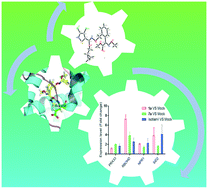Synthesis of potent antifungal 3,4-dichloroisothiazole-based strobilurins with both direct fungicidal activity and systemic acquired resistance†
Abstract
To continue our efforts to discover novel fungicide lead structures, a series of 3,4-dichloroisothiazole-based-strobilurin derivatives were synthesized and characterized. In vitro bioassay screening with 9 different plant pathogens suggested that the linker between 3,4-dichloroisothiazole and the pharmacophore played a critical role in fungicidal potency and scope. Among these, compound 2a with a cis-methoxy oxime ether as a linker was a better active compound. Further modification of 2a, 4a and 6a by replacement of carboxylic ester with a carboxamide led to the best active compound 7a in this study. In vivo bioassay screening and verification indicated that compounds 1c and 7a displayed the best efficacy against wheat white powder (Erysiphe graminis) and corn rust (Puccinia sorghi Schw). In addition, compound 7a was validated by upregulating salicylic acid (SA) signaling and reactive oxygen species (ROS)-related gene expression. A potent lead compound with a broad spectrum of fungicidal and systemic acquired resistance activity has been discovered by bridging 3,4-dichloroisothiazole and the strobilurin pharmacophore with various linkers.



 Please wait while we load your content...
Please wait while we load your content...